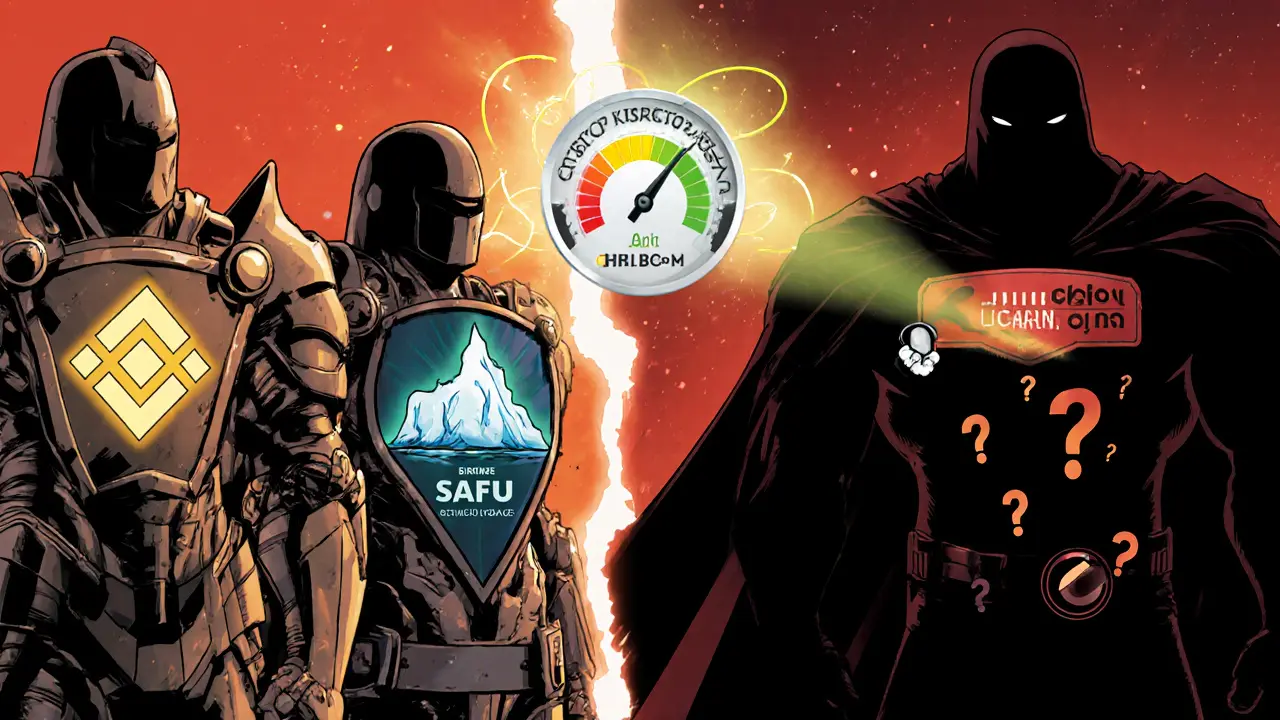HB.top Crypto Exchange Risk Checker
Use this tool to assess the trustworthiness of HB.top based on key security and operational factors. Each factor contributes to an overall risk score.
Risk Assessment Result
Key Concerns Identified:
Key Takeaways
- HB.top provides a basic suite of trading tools but lacks public security documentation.
- Major exchanges like Binance, Kraken and Crypto.com score higher on security audits and insurance.
- Fees on HB.top are competitive, yet hidden costs may appear in withdrawals.
- Regulatory compliance information for HB.top is scarce, raising red‑flag concerns.
- Do thorough due‑diligence before depositing sizable amounts on HB.top.
Choosing a crypto exchange feels a bit like picking a bank you’ll never see. You want low fees, solid security, and some reassurance that the platform follows the law. When a new name like HB.top is a crypto exchange offering spot trading, futures and staking services pops up, the natural reaction is to wonder: does it actually deliver?
What Is HB.top?
HB.top launched quietly in early 2024 and markets itself as a “global crypto marketplace with ultra‑low fees.” The website showcases a clean dashboard, a mobile app for iOS and Android, and a promise of 24/7 customer support. However, the platform’s public footprint is thin - there are no press releases from major crypto news outlets, no detailed whitepaper, and limited user reviews on reputable forums.
Security Checklist - What to Look For
In 2025, any trustworthy exchange must tick several security boxes. Below is a quick audit you can run on HB.top and any other platform you consider.
- Two‑Factor Authentication (2FA): The first line of defense. HB.top offers Google Authenticator, but the setup process is buried in the account settings.
- Cold Storage: Secure exchanges keep the bulk of assets offline. HB.top claims “most funds are stored in cold wallets,” yet provides no percentage or third‑party audit to back the statement.
- SSL / Encryption: Look for HTTPS and a valid SSL certificate. HB.top uses a standard TLS 1.3 certificate, which is good, but it does not publish its encryption standards for data at rest.
- Third‑Party Security Audits: Reputable platforms publish audit reports from firms like Trail of Bits or Quantstamp. HB.top has not released any such report.
- Insurance Coverage: Some exchanges maintain a fund to reimburse users after a breach. HB.top mentions “insurance for custodial assets” but gives no details on the insurer or coverage limits.
- IP Whitelisting & Alerts: Advanced tools that limit log‑ins to approved IPs and send real‑time breach notifications. HB.top’s interface does not expose these options.
For reference, Kraken is a crypto exchange that stores 95% of user funds in air‑gapped cold storage and runs regular third‑party penetration tests. Binance provides the Secure Asset Fund for Users (SAFU), an insurance‑style reserve that has paid out after several high‑profile hacks. These examples illustrate the level of transparency you should expect.
Regulatory & Compliance Status
Legitimate exchanges register with financial authorities - for example, FinCEN in the U.S. or the FCA in the U.K. HB.top lists a corporate address in Seychelles, a common jurisdiction for crypto firms, but offers no registration numbers or license details. The lack of clear KYC/AML policies on the public site is another warning sign. In contrast, Crypto.com is a globally regulated exchange holding licenses in multiple jurisdictions, including a Money Services Business registration in the U.S. and publishes its compliance framework openly.
Fees and Trading Costs
HB.top advertises a maker‑taker model: 0.10% for makers and 0.20% for takers. Spot trading fees are in line with industry averages, but the real test comes with withdrawals. HB.top charges a flat fee for each crypto withdrawal, plus a network fee that can be higher than on larger exchanges during congestion. For example, withdrawing BTC costs 0.0005BTC on HB.top versus 0.0003BTC on Binance. These hidden costs can add up for active traders.

Liquidity, Trading Pairs, and Platform Usability
Liquidity determines how quickly you can enter or exit a position without slippage. HB.top lists around 120 trading pairs, focusing on major coins (BTC, ETH, USDT) and a handful of altcoins. The order book depth is modest, leading to noticeable slippage on large trades.
The web interface is responsive, and the mobile app mirrors the desktop experience. However, the charting tools are limited to basic candlesticks; there’s no built‑in indicator library like TradingView, which many traders rely on.
User Experience & Community Feedback
Searching Reddit, Trustpilot, and major crypto forums yields only a handful of mentions of HB.top, most of which are brief “I signed up, it works” posts. No extensive reviews, no reported security incidents, but also no independent verification of the platform’s claims. By comparison, Binance, Kraken and Crypto.com have millions of user reviews, both positive and critical, providing a clearer picture of their strengths and weaknesses.
Feature Comparison
| Feature | HB.top | Binance | Kraken | Crypto.com |
|---|---|---|---|---|
| 2FA | Google Authenticator (optional) | Google Authenticator, SMS, YubiKey | Google Authenticator, SMS | Google Authenticator, SMS, FIDO2 |
| Cold Storage Ratio | Not disclosed | ~95% | 95% | ~93% |
| Third‑Party Audits | None published | Annual audit (KPMG) | Quarterly audits (Trail of Bits) | Bi‑annual audits (Quantstamp) |
| Insurance Fund | Vague claim, no details | SAFU (>$1B) | Insurance via Lloyd's syndicates | Insurance coverage up to $250M |
| Regulatory Licenses | None listed | Multiple global licences | FinCEN MSB, FCA registration | FinCEN, FCA, and others |
| Trading Fees (maker/taker) | 0.10% / 0.20% | 0.10% / 0.10% (discounted tiers) | 0.16% / 0.26% | 0.20% / 0.25% |
| Number of Pairs | ≈120 | ≈1,200 | ≈300 | ≈400 |
Red Flags & Due‑Diligence Steps
Given the sparse public information, treat HB.top with caution. Here’s a simple checklist before you commit any capital:
- Verify the existence of a valid SSL certificate by clicking the padlock in the browser.
- Search the exchange’s name plus “security audit” or “regulatory license” on Google. If results are empty, that’s a warning.
- Check community forums (Reddit r/CryptoCurrency, Bitcointalk) for any mention of hacks or user complaints.
- Test the withdrawal process with a small amount (e.g., $50) to see actual fees and processing time.
- Read the platform’s terms of service thoroughly - look for clauses that limit liability or allow unilateral changes.
Final Verdict - Should You Trade on HB.top?
Even though HB.top crypto exchange review shows a platform with competitive fees, the lack of transparent security practices, missing regulatory documentation, and limited community feedback tip the scales toward caution. If you’re a casual trader looking to test a tiny amount, HB.top might be worth a quick glance. For anyone handling more than a few hundred dollars, a better‑known exchange with proven security audits, insurance funds, and clear licensing-such as Binance, Kraken, or Crypto.com-offers a much safer environment.
Frequently Asked Questions
Is HB.top regulated?
Publicly available information does not list any financial‑services licenses for HB.top. The exchange lists a Seychelles address but provides no registration numbers, which suggests it may not be regulated in major jurisdictions.
What security measures does HB.top offer?
HB.top supports Google Authenticator‑based 2FA and claims to store most assets in cold wallets, but it does not publish percentages, audit reports, or insurance details. The platform also lacks IP whitelisting and real‑time breach alerts.
How do HB.top withdrawal fees compare to other exchanges?
HB.top charges a flat fee per withdrawal plus the network fee. For Bitcoin, the flat fee is 0.0005BTC, which is higher than Binance’s 0.0003BTC fee but comparable to many mid‑size exchanges. Users should check each coin’s specific fee schedule before transferring large sums.
Can I trust the liquidity on HB.top?
The exchange lists about 120 pairs, and order‑book depth is modest. Large orders can experience noticeable slippage, especially on less‑traded altcoins. For high‑volume trading, larger platforms with deeper order books are safer.
Is there any insurance coverage for funds on HB.top?
HB.top mentions insurance for custodial assets but provides no details on the insurer, coverage limits, or claim procedures. Without transparent terms, users cannot rely on the insurance as a safety net.


Rohit Sreenath
October 3, 2025 AT 11:47Sam Kessler
October 3, 2025 AT 11:59Steve Roberts
October 4, 2025 AT 09:26John Dixon
October 4, 2025 AT 13:46Brody Dixon
October 5, 2025 AT 11:10